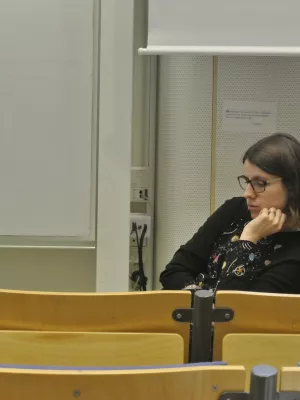
Sanna Alwmark
Postdoc

Mineralogy, Morphology, and Emplacement History of the Maaz Formation on the Jezero Crater Floor From Orbital and Rover Observations
Författare
Summary, in English
The first samples collected by the Perseverance rover on the Mars 2020 mission were from the Maaz formation, a lava plain that covers most of the floor of Jezero crater. Laboratory analysis of these samples back on Earth would provide important constraints on the petrologic history, aqueous processes, and timing of key events in Jezero crater. However, interpreting these samples requires a detailed understanding of the emplacement and modification history of the Maaz formation. Here we synthesize rover and orbital remote sensing data to link outcrop-scale interpretations to the broader history of the crater, including Mastcam-Z mosaics and multispectral images, SuperCam chemistry and reflectance point spectra, Radar Imager for Mars' subsurface eXperiment ground penetrating radar, and orbital hyperspectral reflectance and high-resolution images. We show that the Maaz formation is composed of a series of distinct members corresponding to basaltic to basaltic-andesite lava flows. The members exhibit variable spectral signatures dominated by high-Ca pyroxene, Fe-bearing feldspar, and hematite, which can be tied directly to igneous grains and altered matrix in abrasion patches. Spectral variations correlate with morphological variations, from recessive layers that produce a regolith lag in lower Maaz, to weathered polygonally fractured paleosurfaces and crater-retaining massive blocky hummocks in upper Maaz. The Maaz members were likely separated by one or more extended periods of time, and were subjected to variable erosion, burial, exhumation, weathering, and tectonic modification. The two unique samples from the Maaz formation are representative of this diversity, and together will provide an important geochronological framework for the history of Jezero crater.
Avdelning/ar
- Berggrundsgeologi
Publiceringsår
2023-08
Språk
Engelska
Publikation/Tidskrift/Serie
Journal of Geophysical Research: Planets
Volym
128
Issue
8
Dokumenttyp
Artikel i tidskrift
Förlag
Wiley-Blackwell
Ämne
- Geology
Nyckelord
- Mars
- Perseverance
- remote sensing
- sample return
- spectroscopy
- volcanism
Status
Published
ISBN/ISSN/Övrigt
- ISSN: 2169-9097

